Revisiting The Greubel Forsey Double Tourbillon 30°
by Tim Mosso
With the recent announcement that Greubel Forsey will be instituting a new program called Renaissance d’une Montre as of 2023, which will allow collectors to change anything they like about their watches, we thought it a good time for an in-depth look at what is perhaps the brand’s most underrated ultra haut-de-gamme option for collectors of modern watchmaking, the Double Tourbillon 30° (-ed).
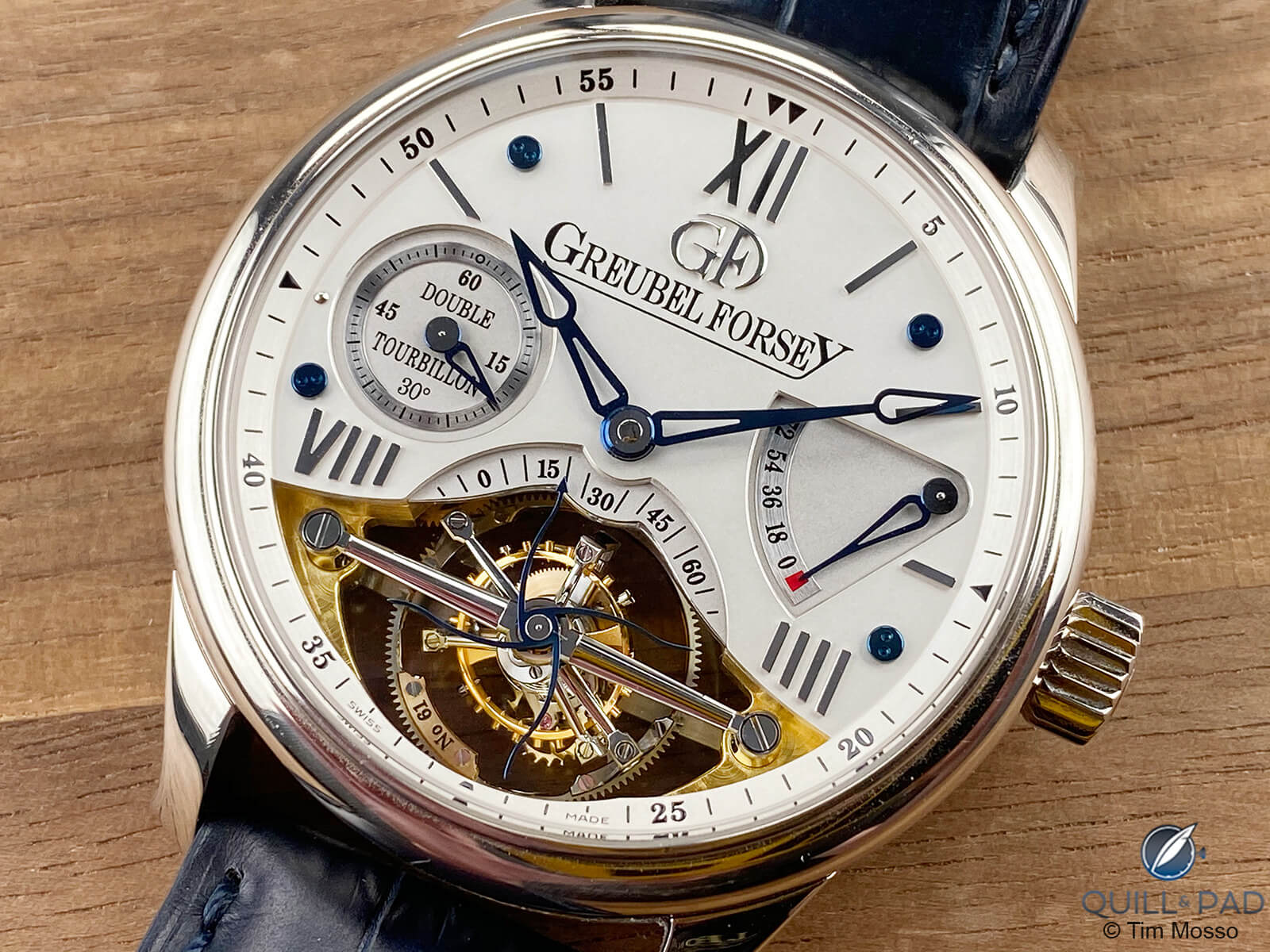
Greubel Forsey Double Tourbillon 30°
As the debut timepiece from a major horological independent, the Greubel Forsey Double Tourbillon 30° might be expected to command the kind of reverence, attention, and auction bids associated with early watches from F.P. Journe, Philippe Dufour, Roger W. Smith, and the Grönefeld brothers.
But that’s not the case. For reasons of fashion, marketing, physical size, and social media indifference, Greubel Forsey watches generally have become smart buys for confident collectors. No, the world won’t pat your back and flock to your social media if you buy a Double Tourbillon 30°, but there’s a special satisfaction in cherishing something exquisite for personal pleasure.
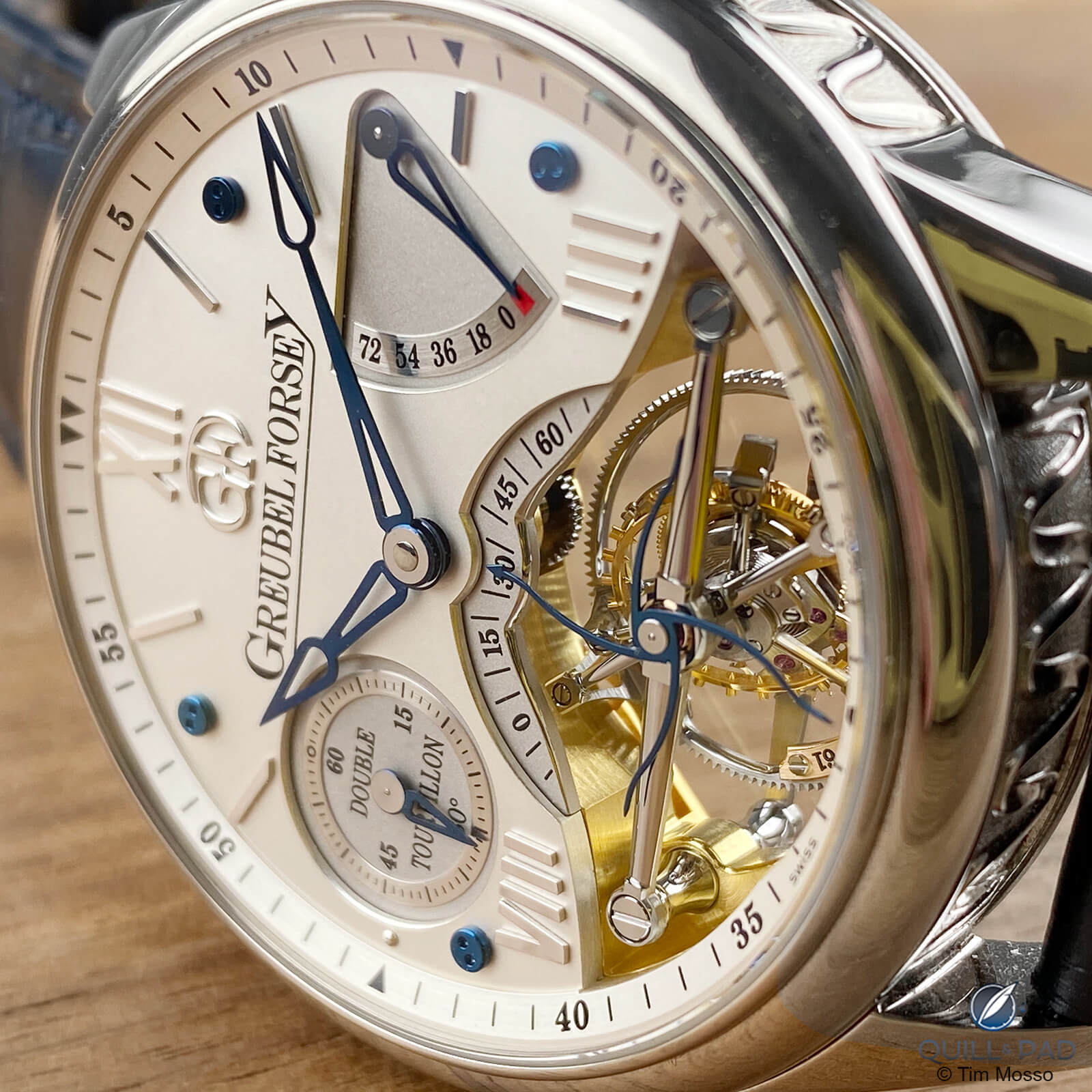
Greubel Forsey Double Tourbillon 30°
The pendulum swing of fashion rarely takes quality, innovation, or scarcity into full account. Today, a mass-produced Rolex or largely machine-executed Richard Mille is the coin of the realm on social media. Greubel Forsey’s virtuoso attention to detail gets lost in the online maelstrom.
As in politics, where the most effective message is the one that fits on a bumper sticker, watch marketing often falters when a product demands too much background and exposition to explain to casual buyers.
Once upon a time in 2004 . . .
Launched in late 2004 for the 2005 model year, the Double Tourbillon 30° exemplified the tourbillon fixation, bold pricing, and size fetish of haute horlogerie in the 2000s. At 43.5 mm, the DT 30° was huge by historic dress watch standards. At over $400,000 in white gold, the watch was priced ambitiously for a new brand’s first offering. Technically, the Double Tourbillon 30° left nothing to be desired.
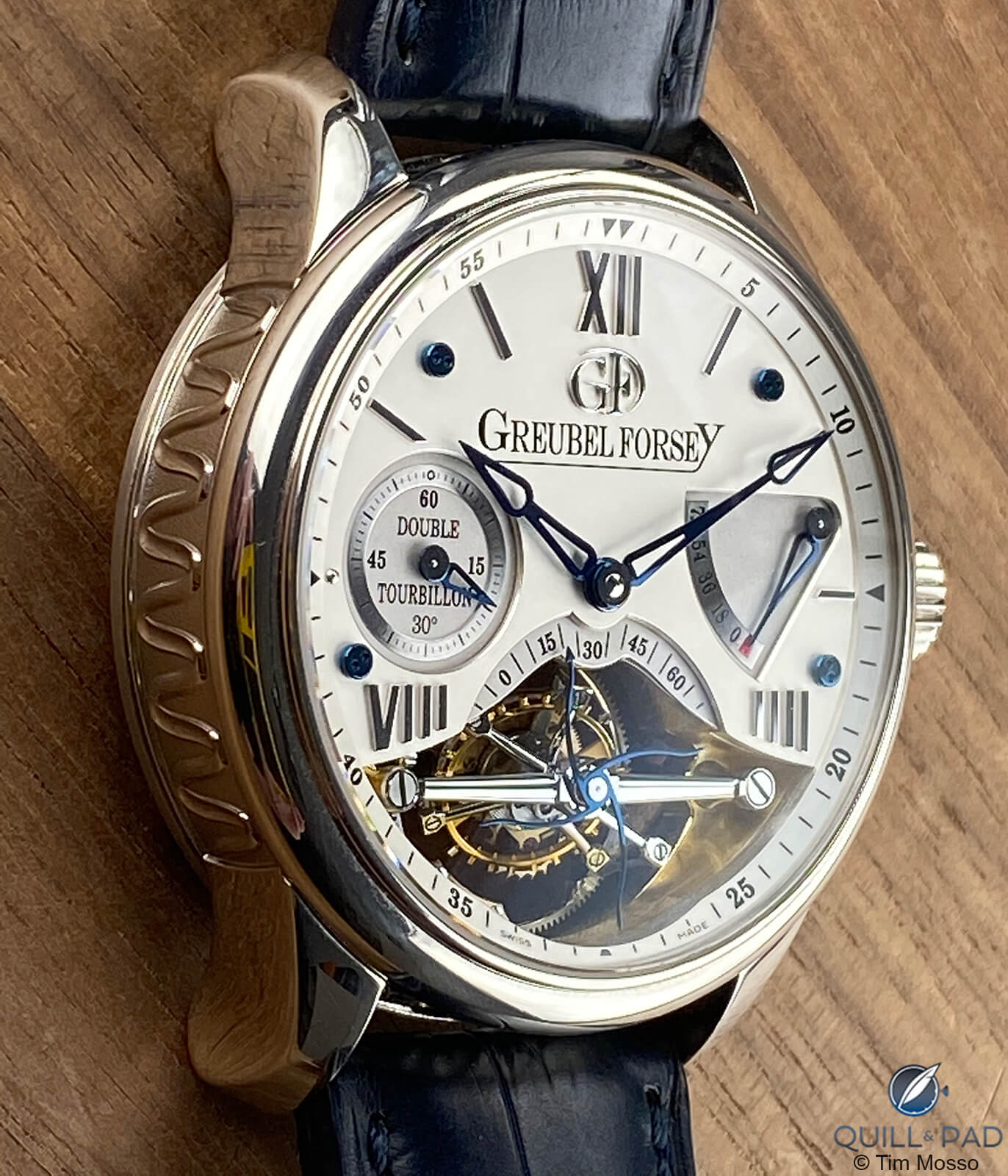
Greubel Forsey Double Tourbillon 30°
On that count, it’s important to recognize that the focus of founders Stephen Forsey and Robert Greubel was chronometry. The cosmetic wristwatch tourbillons of the 2000s were of no interest to the nascent brand from La Chaux-de-Fonds; the intent was to realize Abraham-Louis Breguet’s original vision for his most famous invention: to reduce the impact of gravity on timekeeping.
In 2011, the Double Tourbillon 30° Technique won the Concours de Chronométrie timing test with a score of 915 of 1,000 possible points. Mission accomplished.
Greubel Forsey Double Tourbillon 30°: technology
This milestone achievement was enabled by a series of layered timing refinements. The first and foremost innovation was in the name: Double Tourbillon 30°. Unlike conventional wristwatch tourbillon regulators, the Greubel Forsey design ensures that gravity’s effect on watch timing is minimized regardless of how the watch is worn.
Greubel and Forsey’s 30-degree inclined tourbillon rotates in one-minute circuits to ensure the hairspring cycles through its gravity-induced fast and slow breathing in equal amounts of time. A second tourbillon making one circuit every four minutes spins the balance assembly on a different axis than the inner cage. As a result, whether on the wrist or stationary on a dresser through the night, the Double Tourbillon 30° functions somewhat like a pocket watch tourbillon.
Additional refinements include a free-sprung balance adjusted in six positions, a Phillips overcoil for the hairspring, a full bridge to better brace the tourbillon against shock, and twin mainspring barrels operating in series to apply a flatter torque curve to the operation of the escapement.
Despite spectacular results, Greubel Forsey’s chronometric achievements never have received the same attention as the company’s extravagant design and baroque finishing.
Greubel Forsey Double Tourbillon 30°: design
The Double Tourbillon 30° is a massive presence on the wrist. Robert Greubel takes the design lead while Stephen Forsey focuses on engineering, but both men have a taste for overpowering wrist presence. Incredible as it may seem, the original 43.5 mm Double Tourbillon is something of a mid-size machine by subsequent Greubel Forsey standards.
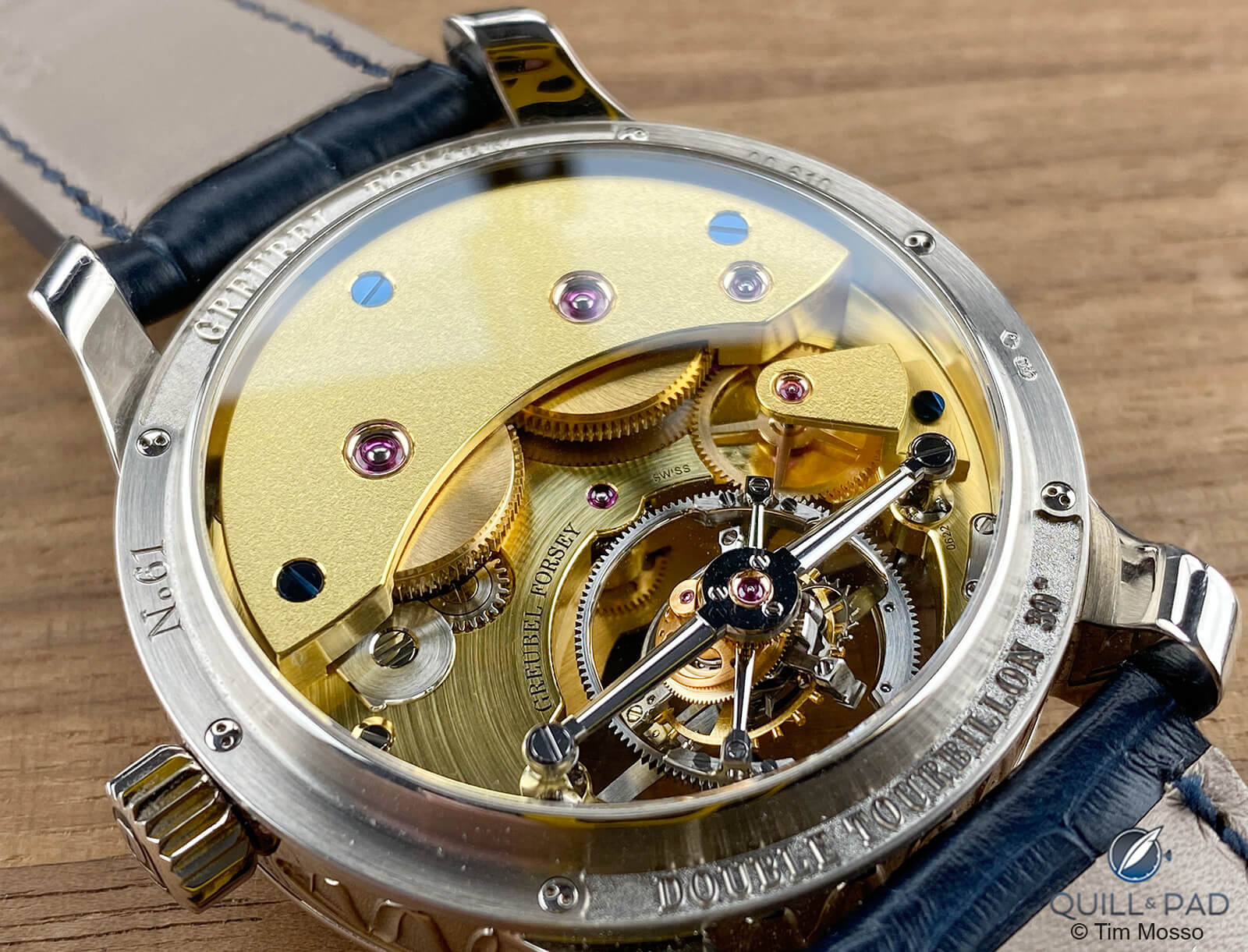
Back of the Greubel Forsey Double Tourbillon 30°
The Double Tourbillon 30°’s case is both massive and intricate. Most online photos fail to capture the watch’s subtle details, including the black-polished concave lugs. The lugs are welded into place by hand and then manually finished to ensure a clean visual break with the case profile; this is an old-school and laborious method of case making, but it’s possible when your manufacture builds just 100 to 120 watches per year.
Also worth highlighting is the sine wave that encircles the Double Tourbillon 30°’s case band. This postmodern flourish is Robert Greubel’s nod to the oscillating heart of the tourbillon and the defining innovation of the watch.
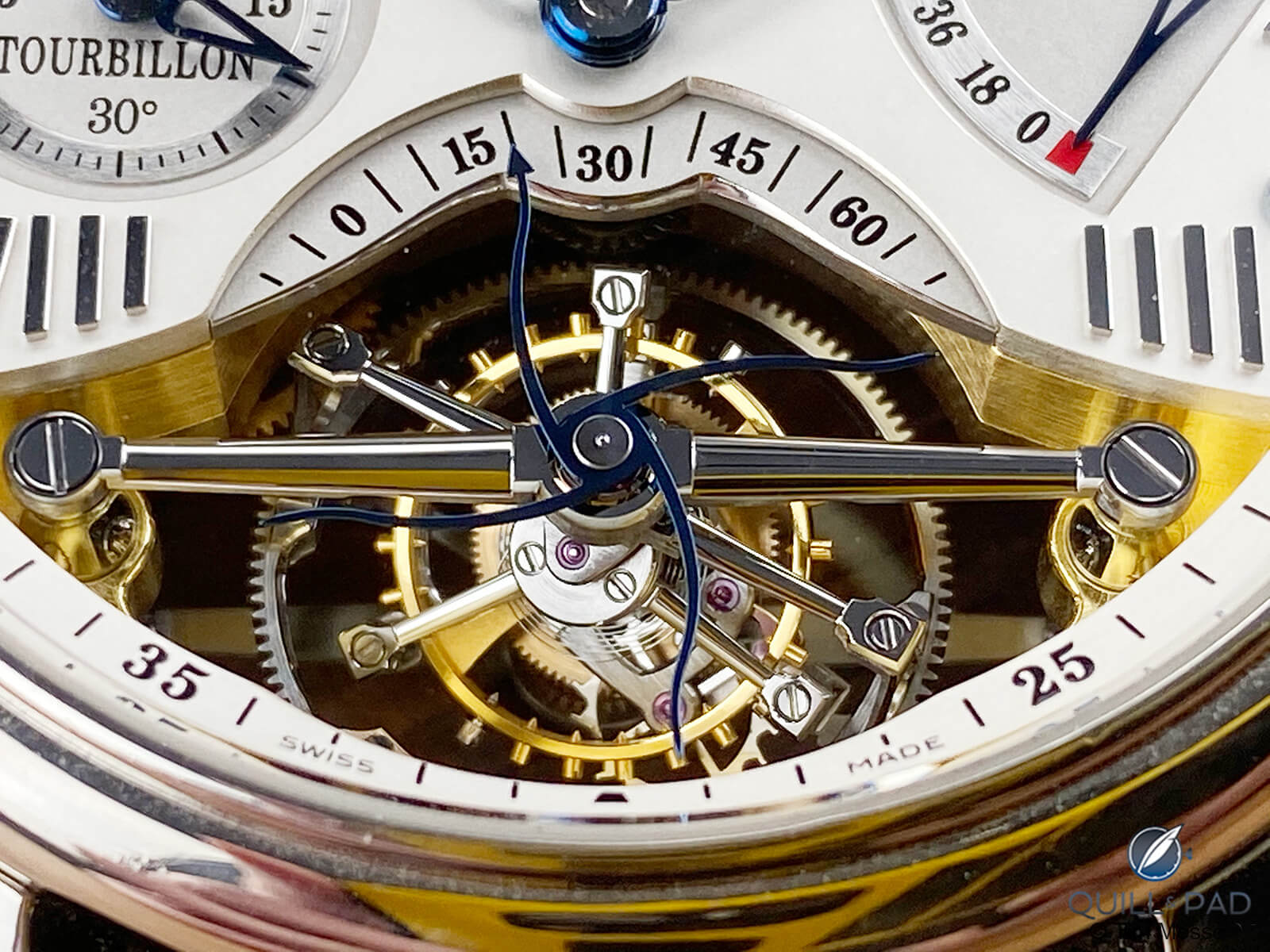
Closeup of the double tourbillon of the Greubel Forsey Double Tourbillon 30°
Dial side, the DT 30° followed 2000s norms and put the tourbillon assembly front and center. At bottom, the twin tourbillon cages perform a synchronized pirouette while the escapement beats at 3 Hz. The tourbillon cages are tall, and their supporting bridge is a mile wide. Hand-finishing includes black polish, sharp interior angles where bevels meet, and mirrored anglage as broad as the beam of a battleship.
Every screw retaining the parts of this caliber is black polished on its top and chamfered down its slot and around its circumference. A fired-blue steel wheel with four serpentine arms acts as the running seconds indicator for the four-minute tourbillon.
Greubel Forsey reserves the upper half of the dial for most practical displays as well as branding. The hours, minutes, and small seconds share space with a power reserve indicator. This indicateur de réserve de marche traces the 72-hour power reserve of Caliber GF02. Given cost-no-object fabrication, the scale for the power reserve needle is crafted from white gold, finished by hand, and then lacquer-filled to create the numerals.

Greubel Forsey Double Tourbillon 30°
Dial-side blued screws and white gold appliqué hours offer rich flourishes calculated to convey opulence. And the dial itself is a solid disk of 18-karat gold galvanized in several different colors depending on the sub model.
Critically for collectors who may consider the original Double Tourbillon 30°, Greubel Forsey’s controversial philosophie text is nowhere to be found on this design. The reams of French verbiage that would come to dominate the flanks and case backs of later Greubel Forsey designs have no presence on the brand’s original product.
Greubel Forsey Double Tourbillon 30°: finishing
On the back, Greubel Forsey earns its reputation for best-in-the-business detail. Caliber GF02 is calculated to evoke vintage La Chaux-de-Fond pocket watch design, but the execution surpasses antiquity’s best efforts. The bridges and plates are constructed of maillechort, a nickel-copper-zinc alloy often called German silver. Greubel Forsey employs its unique “jade gold” gilding to create an even warmer effect. All bridges are frosted, and the base plate of the movement bears satin concentric grain from engine turning.
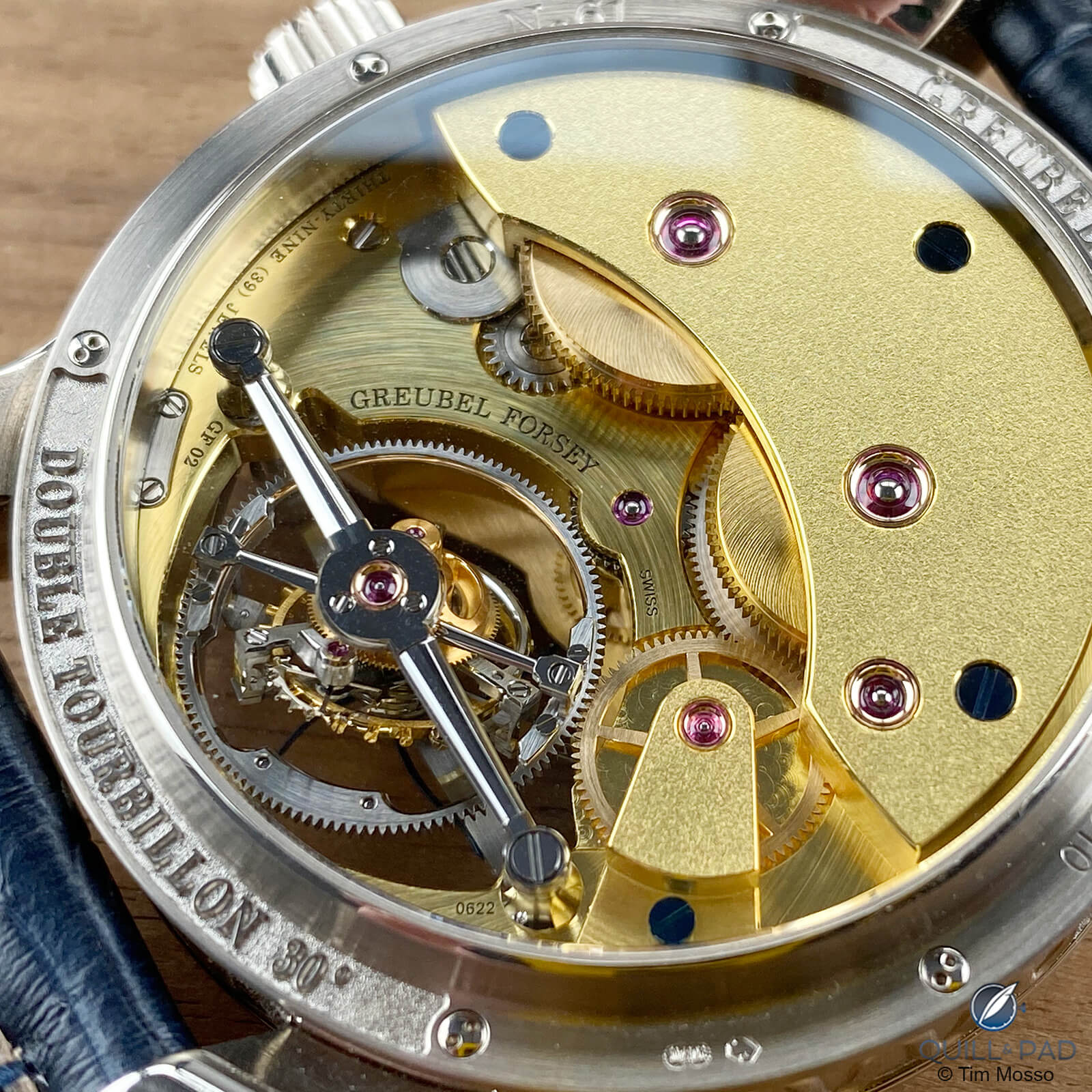
Back of the Greubel Forsey Double Tourbillon 30°
Nods to the pocket watch era extend to the use of pivot stones in gold chaton mountings.
The underside of the Double Tourbillon 30° tourbillon structure is as blindingly finished in specular shine as the dial side. Its power source, in the form of two fast-rotating, series-coupled barrels, features the same deep satin grain as the train wheels. Exceptionally, Greubel Forsey bevels the inner circumference and spokes of its wheels; this measure creates more opportunities to fashion interior angles where the bevels meet.
Given that many Geneva Hallmark-level movements include not a single interior beveled angle, Greubel Forsey’s use of dozens on wheels alone speaks to this team’s refusal to compromise.

Back view of the Greubel Forsey Double Tourbillon 30°
Greubel Forsey isn’t Rolex, Patek Philippe, F.P. Journe, Richard Mille, MB&F, or Grönefeld. While those brands ride a wave of pop culture and social media obsession, the arguably superior timepieces of Robert Greubel and Stephen Forsey remain widely available on eBay, Chrono24, Watchbox, and vendor sites. And while a $270,000 secondary-market Double Tourbillon 30° cannot be considered a “value” in any conventional sense, it’s worth mentioning that the latest versions of this model sell new for up to $700,000.

Greubel Forsey Double Tourbillon 30°
From an historic standpoint, Greubel Forsey’s most important watch was its first. It remains a milestone for the industry, a landmark for the independent horology movement, and – by the standards of six-figure watches – an underrated gem.
For more information, please visit www.greubelforsey.com/en/collection/double-tourbillon-30.
Quick Facts Greubel Forsey Double Tourbillon 30°
Case: 43.5 x 15.76 mm; white gold, red gold, black titanium, and platinum
Movement: manual winding Caliber GF02, 3 Hz/21,600 vph frequency, four coaxial serially operating fast-rotating barrels, power reserve 120 hours; inner tourbillon inclined at 30° and rotating in 60 seconds; outer tourbillon rotating in four minutes
Functions: hours, minutes, seconds; power reserve indicator
You may also enjoy:
The Greubel Forsey Double Tourbillon 30° Technique: What’s Friction Got To Do, Got To Do With It!?
Greubel Forsey GMT Earth Final Edition: Saving The Best For Last



Leave a Reply
Want to join the discussion?Feel free to contribute!